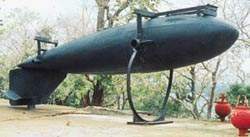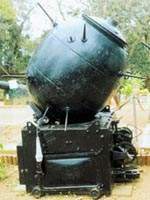Trinco's
spoils of war
Overlooking
the harbour entrance are massive gun emplacements of the Second
World War with their six-inch guns that dominate the approaches
to the anchorage. The weaponry
on display at the naval museum in Trincomalee, atop a ridge at the
navy's sprawling base, provides a remarkable glimpse into our naval
history, bearing testimony to the battles fought for control of
this great deep-water natural harbour during different historical
periods. Other displays
are of more recent vintage - automatic cannon taken off patrol boats
of the Sri Lanka Navy and contact mines deployed by the Tamil Tigers
in the early phase of the Eelam war.
On the same
ridge are the ruins of ramparts built even before the coming of
European colonialists - by the island's monarchs who used Koddiyar
Bay as an anchorage. These were subsequently overlaid by Portuguese,
Dutch and British fortifications. The old cannon
at the entrance, meant to keep at bay enemy men-of-war, were excavated
from the ground where they had been long buried or recovered from
the sea inside the inner harbour area. There are more
such cannon on the bottom of the sea off Elephant Island, according
to Lt Commander Jayantha Gamage, the officer-in-charge of the navy
diving school. The experienced diver has seen the cannon during
numerous dives in the deep-water harbour. The navy has not recovered
the cannon because of the difficulties of preserving the objects
once they are out of the water. The fortifications
built by European colonialists were meant to protect the island's
lucrative trade, particularly in spices. They were used either to
ward off attacks by the Sinhalese of the Kandyan Kingdom or keep
at bay competing European trading companies. This was during
the struggle for supremacy by the world's maritime powers when the
sheltered waters of Trincomalee - what W.A. Nelson in his The Dutch
Forts of Sri Lanka (The Military Monuments of Ceylon) calls the
"greatest naval prize of the Indian Ocean" - became the
focus of fighting between rival fleets. A fortress
built on Ostenburg ridge, which commands the entrance to the inner
harbour and on which the museum is sited, has been called "the
most powerfully gunned fort in Ceylon" with strong batteries
at sea level and many guns on the ridge above them. Unfortunately,
its remains are not to be seen today. In 1795, the
Dutch who were in occupation of Ostenburg at the time, surrendered
to the British fleet after a siege and a brief bombardment. Trincomalee
again became the focus of naval activity in the Second World War
when, in April 1942, Japanese carrier-based aircraft attacked the
harbour and the Royal Navy fleet. It was during
this raid that the Royal Navy aircraft carrier, HMS Hermes, was
bombed and sunk off Batticaloa as it sailed from Trincomalee. At Hoods Tower,
an observation post built by the British that gives the museum its
name, World War 2 vintage field glasses on swivel mounts are still
in working condition and provide a good view of the entrance to
the harbour. The huge gun
emplacements and underground ammunition magazines that make up part
of the museum today were first built in the 1920s by the British.
The six-inch guns have a range of about four kilometres and could
destroy enemy ships approaching Trincomalee. The underground
magazines are impressive construction works with winches and conveyor
belts to bring ammunition up to the surface. The steps leading
down into the chamber some 30 feet underground are coated with silica,
making them luminous in the dark. This was to help defenders to
find their way down without the use of lamps when under attack.
Inside, it
is surprisingly cool - the massive walls and well-placed ventilation
holes helping to keep out the heat. The magazine's chambers are
connected by corridors with sharp turns - meant to prevent shock
waves from nearby explosions reaching the ammunition. The gun positions
have been restored and are well maintained - the massive turrets
with the barrels can still rotate. The gun position
itself has holes bored into its concrete sides - to store ammunition
for immediate use. The guns themselves were hauled up to the top
of the ridge with the use of elephants - as depicted by a painting
of the event reproduced on a board nearby. Three such
guns have been restored at the museum. There used to be guns on
all the ridges overlooking the harbour entrance. The remains of
gun emplacements and an observation post can still be seen on Elephant
Island. One magazine
has been turned into a weapons museum with an interesting collection
of Sten guns, Very pistols, and an old "coaxial gun" used
to pass messages or documents between ships sailing alongside each
other at sea. There are improvised
LTTE contact mines with fuses recovered by navy divers. In another
chamber are guns, mostly improvised, used in the JVP uprising of
1971. Although the navy has done a good job in collecting the weapons and equipment used in the wars that Trincomalee has witnessed over several centuries and in restoring the abandoned gun emplacements and underground magazines, the museum itself is very rudimentary. There are hardly any explanatory notes about the objects on display nor any brochures or information leaflets for visitors. The pressure of war has kept the navy from developing the museum. Hopefully, if the truce holds and peace talks get off the ground, it could pay more attention the island's naval history and future visitors to the museum might be able to see the weaponry of more recent naval action. |
||||||
Copyright © 2001 Wijeya Newspapers
Ltd. All rights reserved. |


